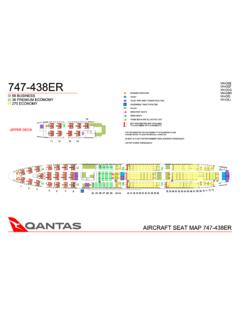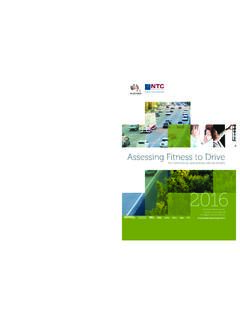Transcription of Qantas Medical Clearance Guidelines - Fly with Australia ...
1 Travel Clearance Guidelines Document owner: Director of Medical Services Document controller: Manager Aviation Health Programs Document name: Qantas Medical Travel Clearance Guidelines QMS 300 June 2020 Qantas Group Medical Travel Clearance Guidelines Airline travel has some unique features which must be considered by passengers with Medical conditions to ensure a safe and comfortable flight. Key features that a passenger and their treating Medical practitioner must consider are: Oxygen: The commercial aircraft cabin is pressurised to a level that is equivalent to being up to 8,000 ft altitude reducing the amount of oxygen available to breath.
2 Healthy people have no problems at these altitudes but passengers with anaemia, or heart and lung conditions may be at risk and supplemental oxygen may be required or travel delayed until their condition has improved. Severe or complex cases may need to have altitude simulation studies to ensure their safety during the flight. Advanced Medical care: The aircraft cabin is a closed environment where access to advanced Medical care may not be possible for many hours depending on the flight path. Qantas flight attendants are trained in first aid and our aircraft carry doctor s Medical kits and heart defibrillators, but complex Medical assessment and treatment is not possible on board.
3 If a passenger is at risk of an illness or complication in flight, they should consider delaying their flight or flying with a Medical escort. Detailed guidance for both passengers and their doctors is provided below. In developing these Guidelines Qantas has considered the IATA Medical Manual and consulted with specialists in the relevant fields. Diagnosis/ Condition Not suitable for travel Travel Clearance Form Required Comments for treating Doctor Group 1 Cardiovascular and related conditions including blood conditions Angina Unstable angina Control achieved only recently (within 14 days) Must be stable and no angina at rest.
4 Must be able to ambulate at a moderate pace 50m on flat ground without chest pain or breathlessness Myocardial infarction (heart attack) Within last 7 days Within 8-21 days or if complications Must be stable with no complications Cardiac failure (congestive cardiac failure) Uncontrolled heart failure or required ventilatory support within the last 14 days Not required if controlled* *Controlled - must be able to ambulate at a moderate pace 50m on flat ground without chest pain or breathlessness Serious cardiac arrhythmia Within 7 days Within 8-21 days Does not include benign arrhythmias Pacemakers and internal (implanted) defibrillators Within 24 hours Within 7 days No evidence of pneumothorax on chest x-ray Coronary Angiogram Less than 24 hours 21 days A myocardial infarction (heart attack)
5 Within 21 days overrides these provisions. Hb> Angioplasty with or without stent 2 days or less 21 days Good outcome with no complications. No significant anaemia Cardiac Surgery where the chest cavity is opened` 9 days or less 10-21 days (CABG and Valve surgery) In assessing fitness to fly, the treating surgeon must in addition to any other assessment; view a chest x-ray to confirm that there is no air in the pleural space. Pulmonary Hypertension WHO Class IV Significant right heart failure WHO Class I, II, III Oxygen is recommended in most cases or consider specialist assessment.
6 Travel Clearance Guidelines Document owner: Director of Medical Services Document controller: Manager Aviation Health Programs Document name: Qantas Medical Travel Clearance Guidelines QMS 300 June 2020 Diagnosis/ Condition Not suitable for travel Travel Clearance Form Required Comments for treating Doctor Group 1 Cardiovascular and related conditions including blood conditions DVT / Pulmonary embolism or at risk of DVT Onset 4 days or less 5-21 days Anticoagulation stable and PAO2 normal on room air. Prophylaxis as indicated. Anaemia Hb less than g/dl Active bleeding Chronic disease Hb < chronic stable disease If acutely anaemic, Hb level should be assessed more than 24 hours after last blood loss, which must have ceased.
7 Consider oxygen requirements Sickle cell disease Sickling crisis in previous 9 days 10 days and over Always require supplemental oxygen Group 2 Respiratory Conditions Pneumothorax Haemo - pneumothorax (As a result of chest trauma or occurring spontaneously) 7 days or less after full lung expansion 8-21 days after full lung expansion Lung expansion should be assessed by chest x-ray, ensuring no air in pleural space Open chest surgery (non-cardiac) 14 days or less 15- 8 days, experiencing symptoms or complications lobectomy, pleurectomy, open lung biopsy.
8 No evidence of pneumothorax on Chest x-ray Pneumonia Acute, with symptoms Within 7 days of resolution - complications or ongoing symptoms Fully resolved or, if x-ray signs persist, must be symptom free COPD, emphysema, pulmonary fibrosis, pleural effusion and haemothorax Cyanosis on the ground despite supplementary oxygen. Unresolved recent exacerbation/ or required ventilatory support within the last 14 days If unstable or poor exercise tolerance of less than 50 metres. Recent exacerbation (7 days) Supplementary oxygen may be required in flight. Altitude simulation studies may be needed Asthma Recent severe attack within 48 hours (requiring hospitalisation) Severe episode or recent hospitalisation discharge (within 48 hrs), recent deterioration or instability Must be stable and have medication with them Group 3 Neurological Conditions TIA (transient Ischaemic Attack) Within 2 days 3-7 days Must be stabilised Stroke (cerebro-vascular accident)
9 Within 3 days 4-14 days Must be self sufficient otherwise escort/carer required Supplemental oxygen should be considered within 2 weeks of CVA Epilepsy/Fitting/ Seizures Less than 24 hours or unstable Within 7 days of last fit. In case of ongoing seizure risk, travel may be approved with escort and treatment plan. Cranial surgery 9 days or less 10-21 days Air travel should not occur if there is any residual air within the cranial cavity. Imaging may be required for early travel Travel Clearance Guidelines Document owner: Director of Medical Services Document controller: Manager Aviation Health Programs Document name.
10 Qantas Medical Travel Clearance Guidelines QMS 300 June 2020 Diagnosis/ Condition Not suitable for travel Travel Clearance Form Required Comments for treating Doctor Group 3 Neurological Conditions Spinal surgery- minimally invasive (ie microdiscectomy) 3days after surgery 4 days with surgeon Clearance Wound should be stable and able to tolerate unexpected turbulence and vibration associated with flight Spinal surgery (major surgery ie open decompression) 8 days after surgery 9 days up to 12 weeks of injury or surgery Wound should be stable and able to tolerate unexpected turbulence and vibration associated with flight.










